Thesis Title: Framework for Pedestrian and NMT Prioritization in Transportation
Category/ Broad Area: Transportation
Aim: To create a pedestrian and non-motorized transport system for satellite towns whose relevance would exist with surrounding developments and advancements
Objectives
- To understand the impact of Intra-city and surrounding development on transportation in cities
- To formulate an ideal situation for transportation composition from households in cities
- To understand exiting practices of pedestrianization and non-motorization with respect to reduction in dependency on private vehicles
- Correlate the studies of ideal and real situations of pedestrian’s/ people’s priority and develop a framework for the same.
Scope
- The proposed framework would be applicable to the scale of satellite towns and is prepared on the basis of Indian contexts.
- The calculated and resulted ideal mode share could be used as benchmark for cities in order to enhance their priority of pedestrians and non-motor users.
- The proposed framework is highly suitable suitability for Greenfield projects and can be used in planning for new satellite towns.
- This framework helps promote shift to sustainable transport options in existing towns and begin with usage these options in new towns.
Limitations
- Certain elements of framework are suitable for brownfield with case/site specific variations in its implementation considerations.
Need for Study
In the midst of development and urbanization, cities have grown in population around various centers and poles of growth. When development is an important quotient of the city, it is also affecting the comfort of people in commuting with ease in multiple ways. A good transport system allows people to reach/ get their services through means of access from their residences. Today, due to surrounding developments and availability and closeness to better facilities, population has increased, resulting in congestion on the streets. This has diverted planning from people to motors. High private vehicle dependency is one of the major reasons for heavy traffic in Indian cities. Building more roads for an unrelenting growth of vehicles is not a solution for the problems like congestion and pollution. India is still experiencing exponential growth in ownership and use of cars owing to various reasons (Verma 2015). 57% of the country’s population own private vehicles with highest traffic congestion recorded in metro cities of Bengaluru, Mumbai and Delhi (NDTV 2020). According to TomTom Traffic Index 2019, Bengaluru (71%), Mumbai (65%), Pune (59%) and New Delhi (56%) ranks 1st, 4th, 5th and 8th respectively among top 10 cities globally (NDTV 2020). Due to high motor usage, all infrastructure is oriented towards motor with lesser priority to pedestrians. Safer modes of commutes that are beneficial in many ways over private vehicles needs to get priority.
The most affected urban space in terms of ease of transportation is in Metropolitan cities. The Indian metro cities like Delhi, Mumbai and Bangalore have high levels of traffic congestion. It parallelly has growing levels of urbanization, population and influx of migrants. To withstand such urban pressures, this study aims at proposing a framework to prioritize sustainable modes of transportation, following the motto, ‘People first, Motor next.’ It also focuses on decreasing dependency on private vehicles, shifting back the focus from motor to people. It will deal with how a good accessibility could be achieved without hindering the development.
Case Study: Yelahanka Satellite Town, Bangalore

Significance/usefulness of the project
While there are design guidelines and standards for infrastructure of sustainable modes, we fail to see any decrease in traffic, especially in metro cities. This shows that, there are other parameters influencing the mobility in the city. This study is significant in 3 ways:
- It provides an ideal mode share that can be a benchmark for mode shares of cities.
- It suggests a framework with its applicability on greenfield and brownfield that can be used in all projects of satellite towns.
- It gives implementation considerations along with suggested proposals in 4 major dimensions of safety, comfort, travel time and experience.
Abstract:
In today’s world, due to rapid urbanization and increase in population, many cities have high urban pressures to withstand. This is impacting on the transportation system which is highly evident in metropolitan cities. It has resulted in high private vehicle dependency and thus, planning for transportation has shifted its focus from people to motors. This study focuses on prioritizing people over motors by proposing a framework for their prioritization. The scale of this framework is limited to satellite town, as play a key role in decongestion of cities. With an aim of creating a pedestrian and non-motorized transport system for satellite towns whose relevance would exist with surrounding developments and advancements, this study is divided into 5 stages. Stage 1 brings the calculated ideal mode share, stage 2 with literatures that brings out best practices for pedestrian and NMT focus, analysis techniques and methodology, Stage 3 dealing with review of NMT policies in India, stage 4 being the site selection, justification and analysis and the final stage, stage 5, being the proposed framework with its implementation considerations in 4 different dimensions – safety, comfort, travel time and experience – and its evaluation on green field and brown field. The proposed framework would be applicable to the scale of satellite towns and is prepared on the basis of Indian contexts. The calculated and resulted ideal mode share could be used as benchmark for cities in order to enhance their priority of pedestrians and non-motor users. The proposed framework is highly suitable suitability for Greenfield projects and can be used in planning for new satellite towns. Certain elements of framework are suitable for brownfield with case/site specific variations in its implementation considerations. This framework helps promote shift to sustainable transport options in existing towns and begin with usage these options in new towns.
Main Outcomes/ final analysis/ proposals
Based on the observations on site, the proposed framework is as follows:
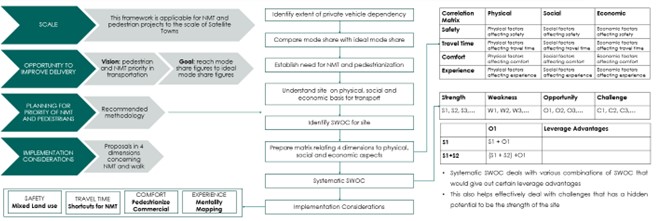
Figure 1: Proposed Framework
The implementation considerations are divided into 4 dimensions of Safety, Travel Time, Comfort and Experience, each of which have the following proposals:
- Safety – Mixed Land use
- Travel time – Short cuts for NMT
- Comfort – Pedestrianize commercial
- Experience – Mentality mapping
Each of these proposals are applied on the site to check for its relevance and applicability
1. Safety – Mixed Land Use
Six identified unsafe areas (through interviews on local residents) were mapped and the reasons as to why they were unsafe was analysed.
Reason: Non- functioning land uses in surroundings after a particular time.
Few of the comments that were made by residents of the area were “Institutions close after 4 pm – Residential areas leave streets unwatched – lonely streets.” The 6 stretches identified based on interviews of local vendors and residents also showed the same characteristics of being unsafe. However, stretch 7 was taken for observation.
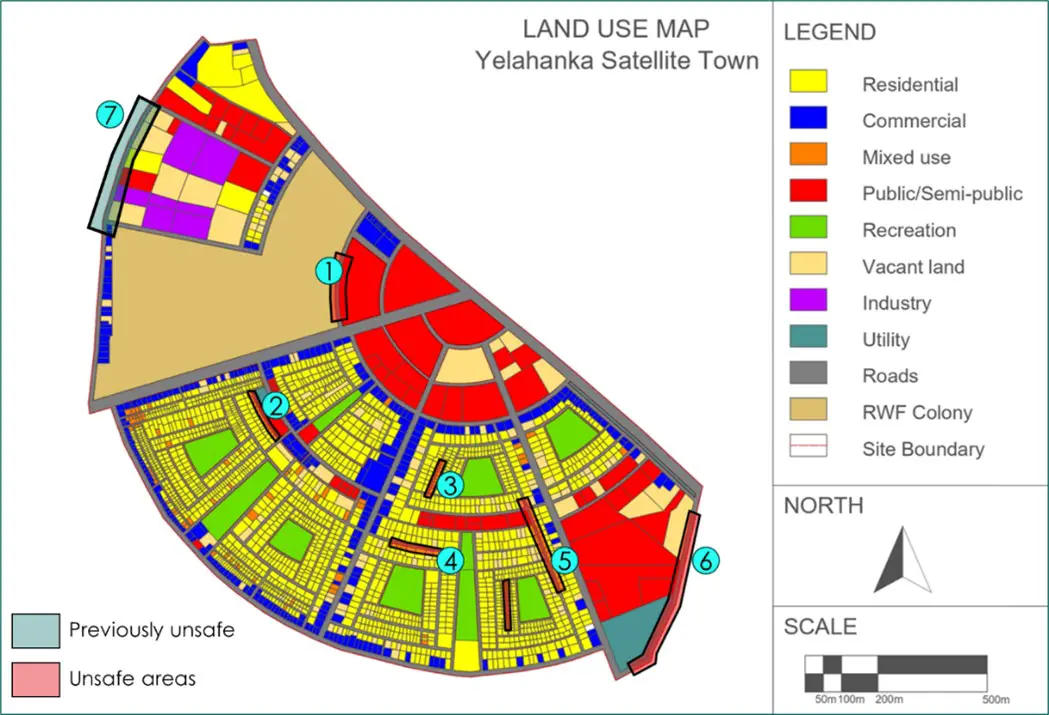
Figure 2: Unsafe streets of Yelahanka Satellite Town
Stretch 7: Observation Study
- Previously the stretch was highly unsafe to walk – even with presence of streetlights (through interview of frequently travelling pedestrians in the stretch)
- From past 2 – 3 months, the streets are safe to walk.
Reason:
- Street vendors occupied the walkways in the stretch
- Increased watch over the stretch until 10pm
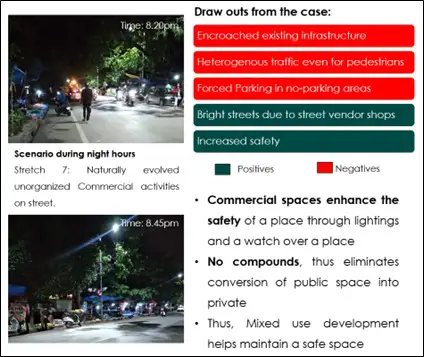
Figure 3: Observation study of previously unsafe Stretches
What we understand from the observation study is that, commercial activities in the stretch means that there is effortless watch on the streets along with good lighting. But since street vending is an encroached activity here, new projects can propose the mixed-use development to enhance safety in the streets.
2. Comfort – Pedestrianize Commercial
Considering the boundaries of Satellite Town, the most frequent trip purpose is commercial (maximum proportion of people going weekly twice)
In the commercial Stretch, the proposed interventions include:
- Restrict Motor-vehicles
- Scheduled entry of stock vans for Commercial shops
- Service Lane for service vehicles
- Alternate bus and motor routes
- Provision of rentals: Cargo-bikes and Bicycles
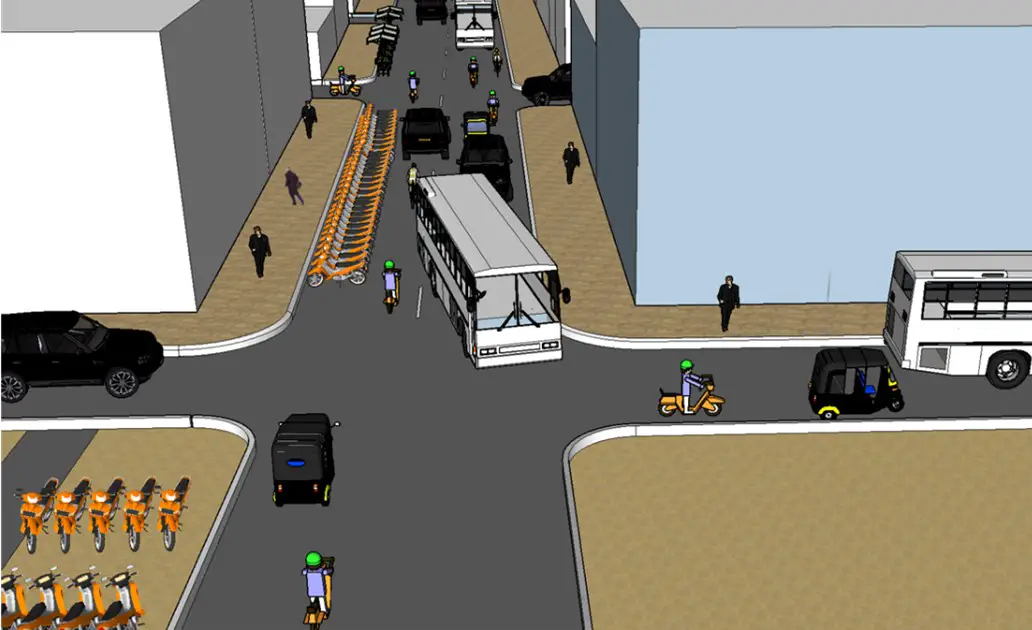
Figure 4: Existing Junction View of commercial stretch
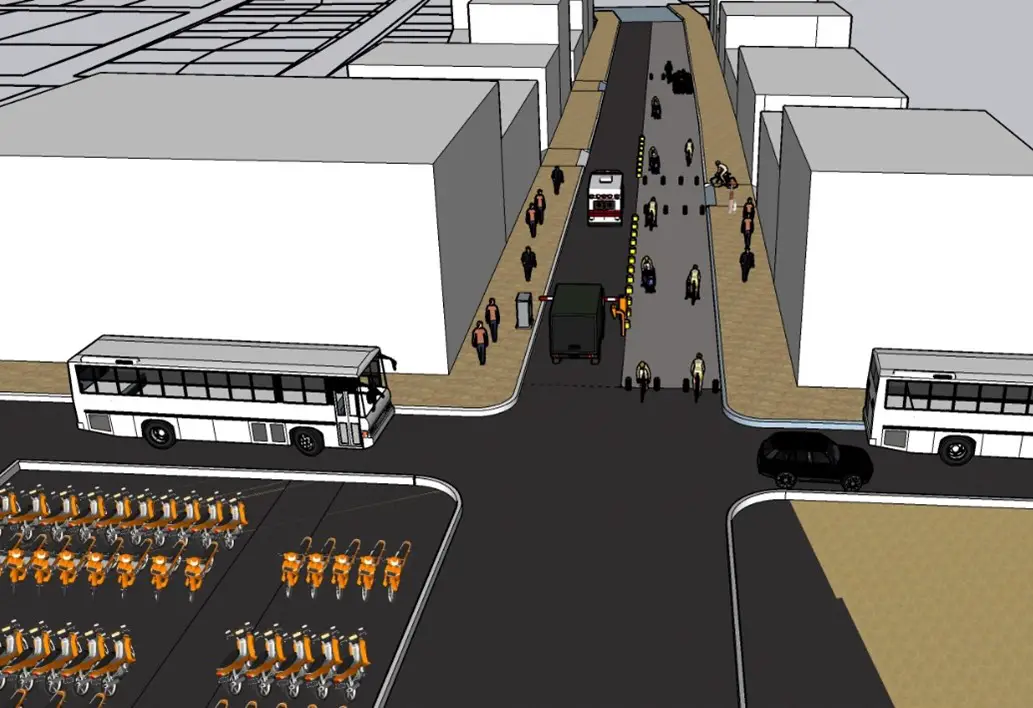
Figure 5: Proposed Junction view
- During Peak Hours:
- Service lane could be used by non-motor users and street vendors for vending and purchase activities
- Stations of rentals could be provided in strategic locations
- The bus-depot can now act as NMT Depot for rental bikes
- Special incentives for shop owners providing NMT parking
- During Non-Peak Hours:
- Gates present at both sides of entrance
- All shops must register to the system – gates open on showing a smart card
- Gates sense and automatically open for service vehicles
- One-way entrance for stock vans
- Two-way entrance for service vehicles
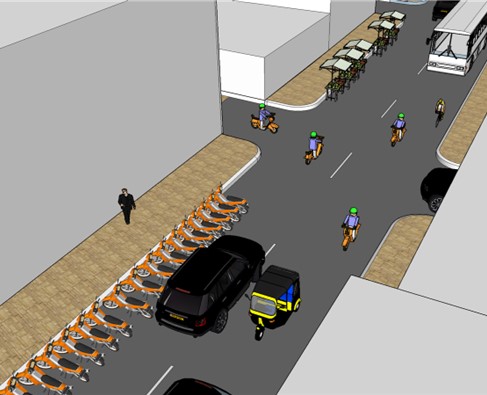
Figure 7: Existing – Parking and Street hawker encroachment
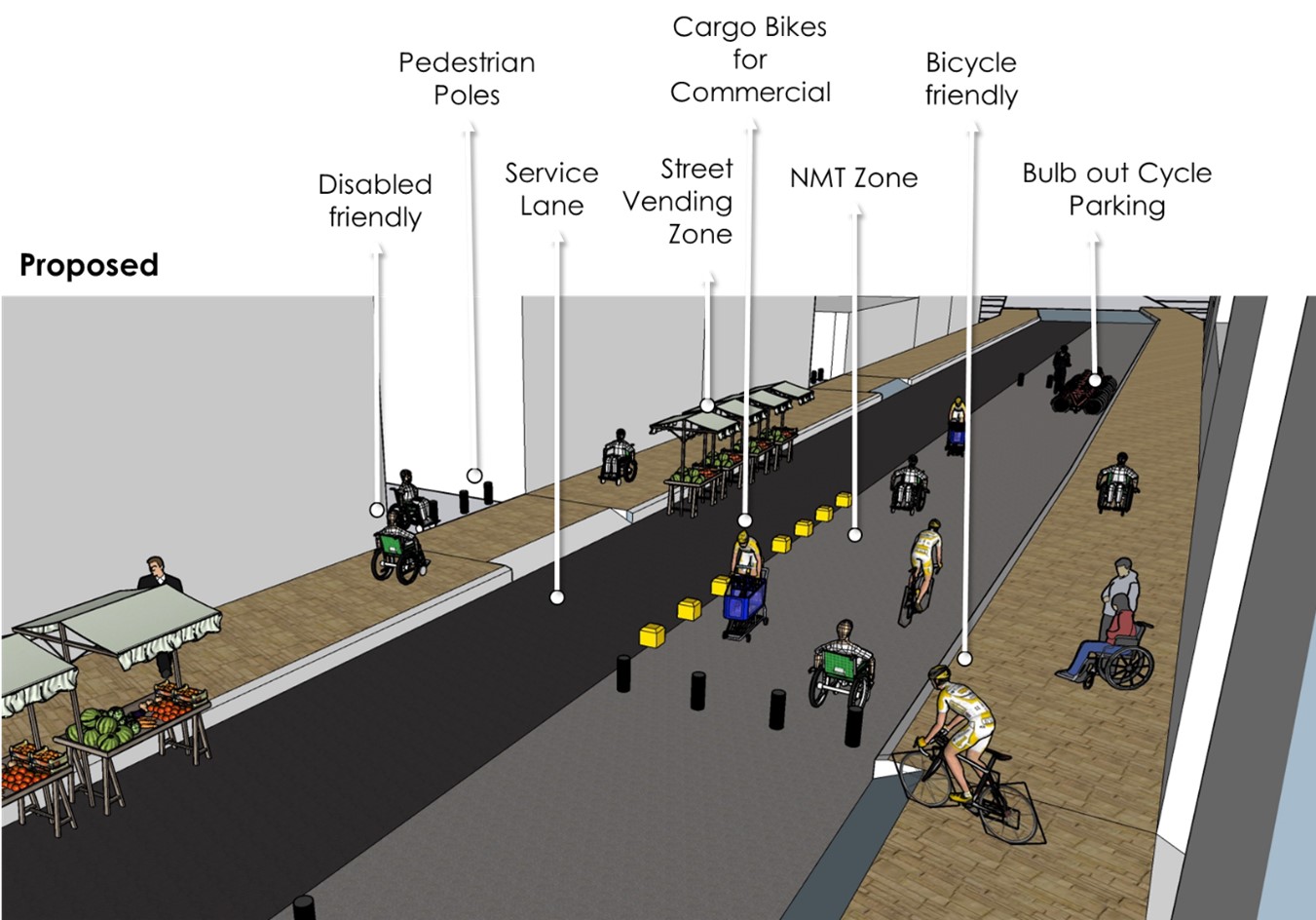
Figure 8: Proposed View
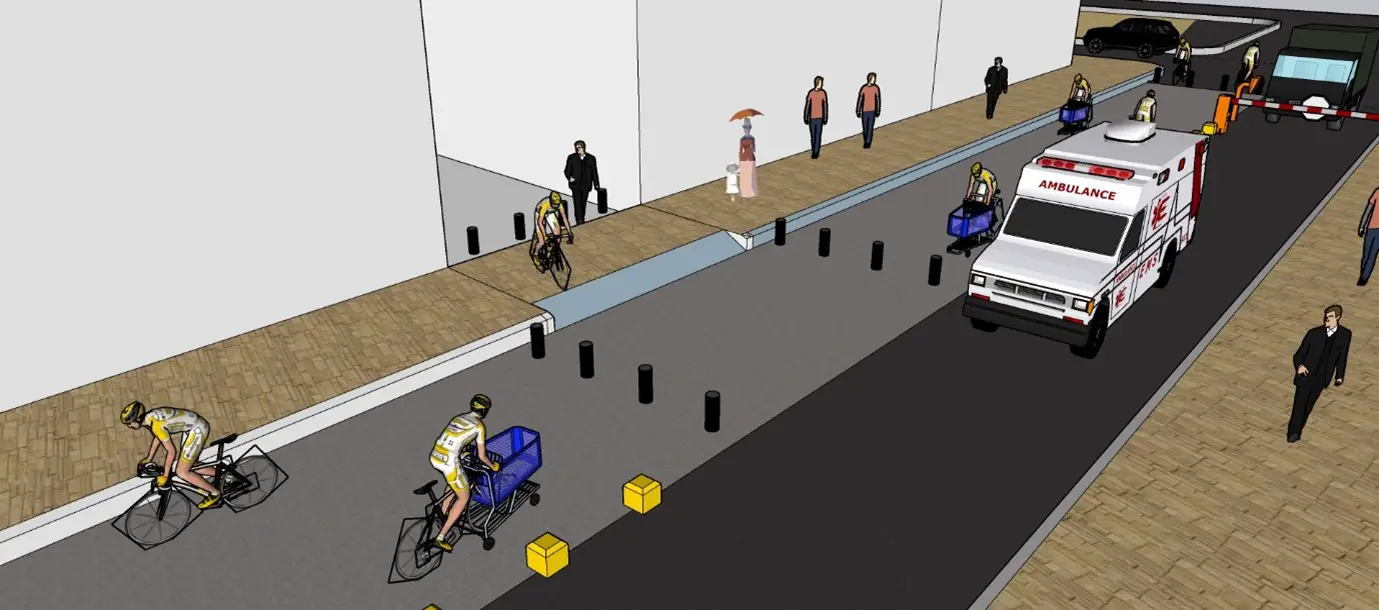
Figure 9: Proposed Lane Bifurcations
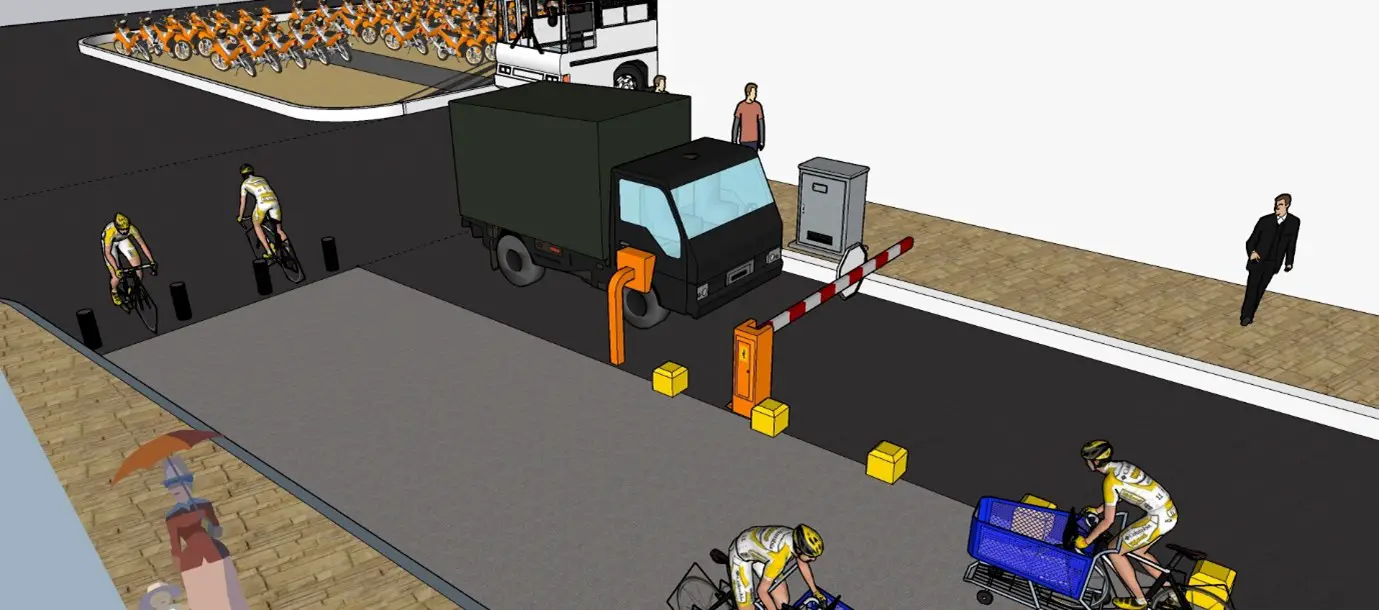
Figure 10: Proposed restricted entry on service lane
What is hindered in this process is the bus-route for public buses. However, we use one of the strengths of the site which is “Various Alternative Routes.” Therefore, those routes that previously followed the commercial road will now have another proposed route.
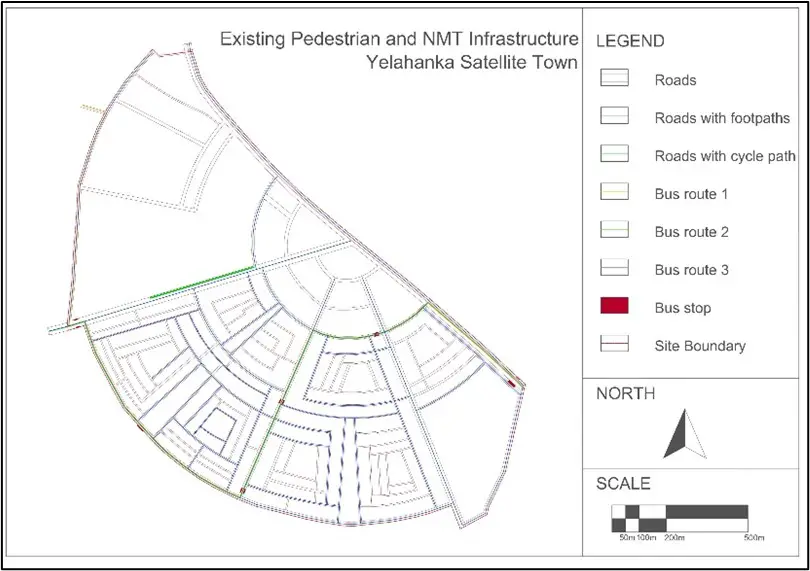
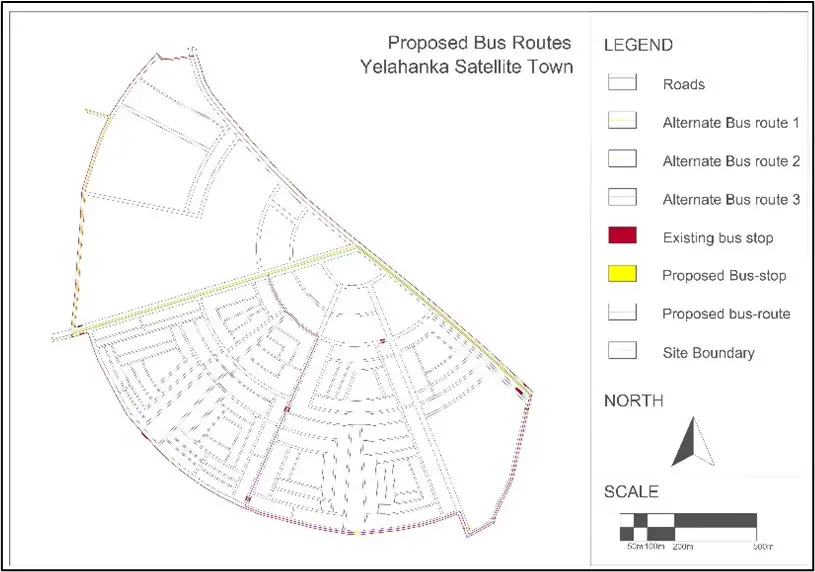
3. Travel Time – Short cuts for NMT
Common Constrain in sites include physical Barriers, most frequent constraint being obstructing Nalas. However, if the physical constraint used as a strength for NMT zone, it becomes an essential shortcut for non-motor users.
Physical constraint + buffer zone = Consumption of potential space (Systematic SWOC)
Water flows in shortest routes, regardless of human induced development. Thus, Proposed intervention could be:
- Initiate nala cleaning and development in integration with walk and NMT.
- No private vehicle allowed
- NMT gets a short cut route
4. Experience – Mentality Mapping
Experience is a subjective matter where what one person enjoys may differ from the other. Since it is a psychological aspect, the survey must involve an approach that understands people’s mentality that influences their choice of mode. The most apt method here would involve mapping of people’s mentality using the Theory of planned behavior. The theory of planned behavior is an approach that links psychological aspects to socio-economic profile and travel behavior. (Kaewkluengklom 2016)
Mentality mapping involves the following steps:
- Identify Intention and behavior of community
- Identify what is stopping the community from using sustainable modes
- Understands psychological gaps
- Initiatives that match the results of analyses
- Encourages walk and NMT
- Ensures good experience through these modes
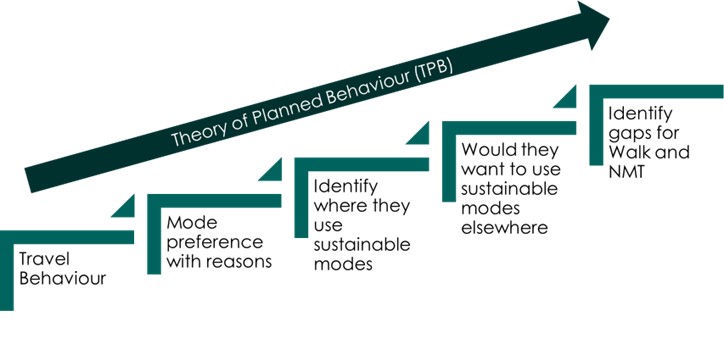
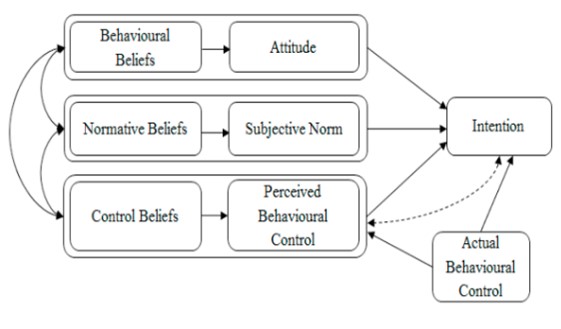
Figure 11: Theory of Planned Behaviour – approach
The above implementation considerations are evaluated to check their applicability to greenfield and brownfield projects, which are as follows:
- SAFETY – Mixed Land use:
- Suitable more to Greenfield than brownfield
- Low suitability to brownfield
- COMFORT – Pedestrianize commercial:
- Suitable for planned neighbourhoods in brownfield
- High Suitability for green field
- TRAVEL TIME – Shortcuts for NMT:
- Highly suitable for green field
- Moderate suitability for brown field
- EXPERIENCE – Mentality Mapping:
- Suitable for both Green and Brown field
Keywords: Ideal mode share, pedestrians, non-motorized transport, priority, transportation, Indian cities.
Author: Nidhishree N Kumar, Undergraduate (B. Planning)
Guide & Co-guide: – Asst. Prof. Rohini N, Prof. Vidhyadhar S Wodeyar
College: – Nitte School of Architecture Planning and Design
Declaration by Author: I have authorized Planning Tank to publish this information and the thesis is a work done by Nidhishree N Kumar and Planning Tank is not responsible for any information presented.
Declaration by Planning Tank: The information presented is provided by the author with no inputs from Planning Tank. Author has conducted the above stated study and can be contacted for more information. Planning Tank is authorized to contact the author if more information is required about the research work for information author about job opportunities and other purposes.